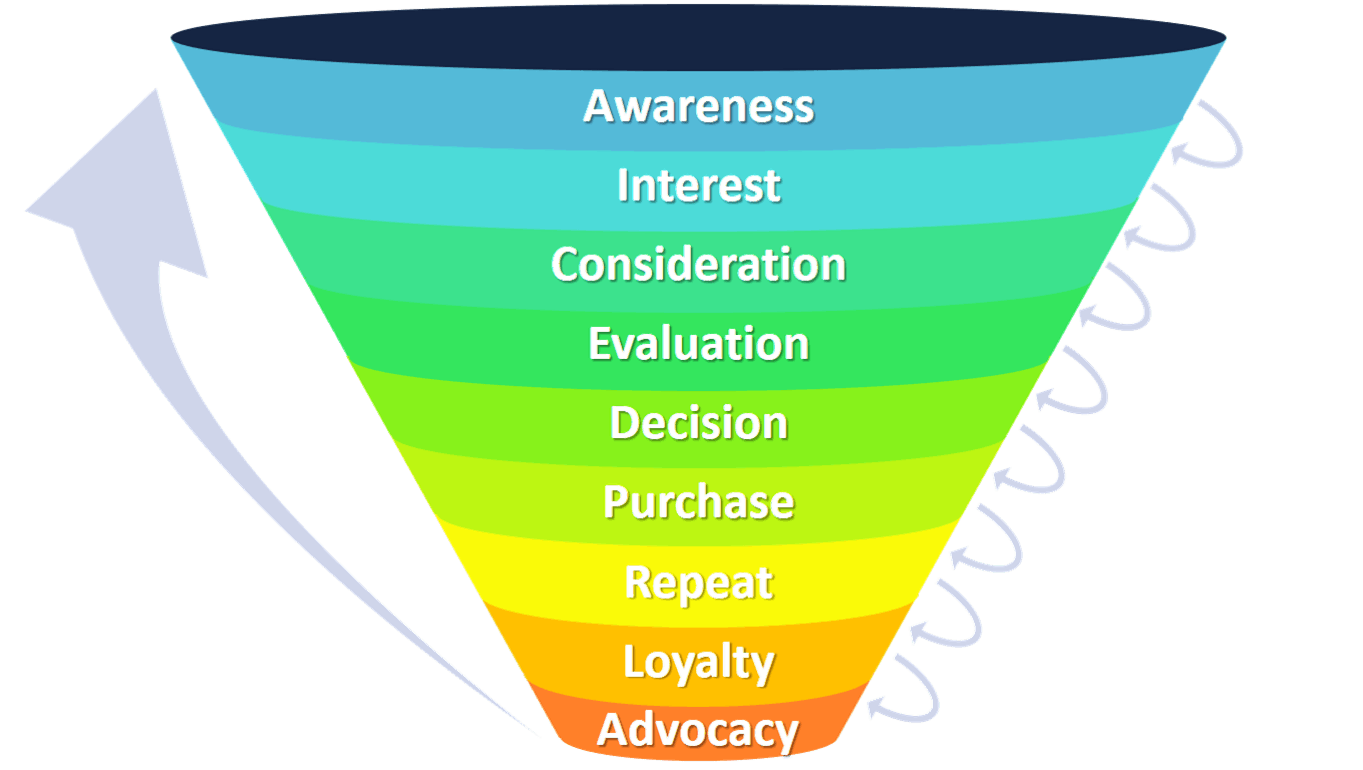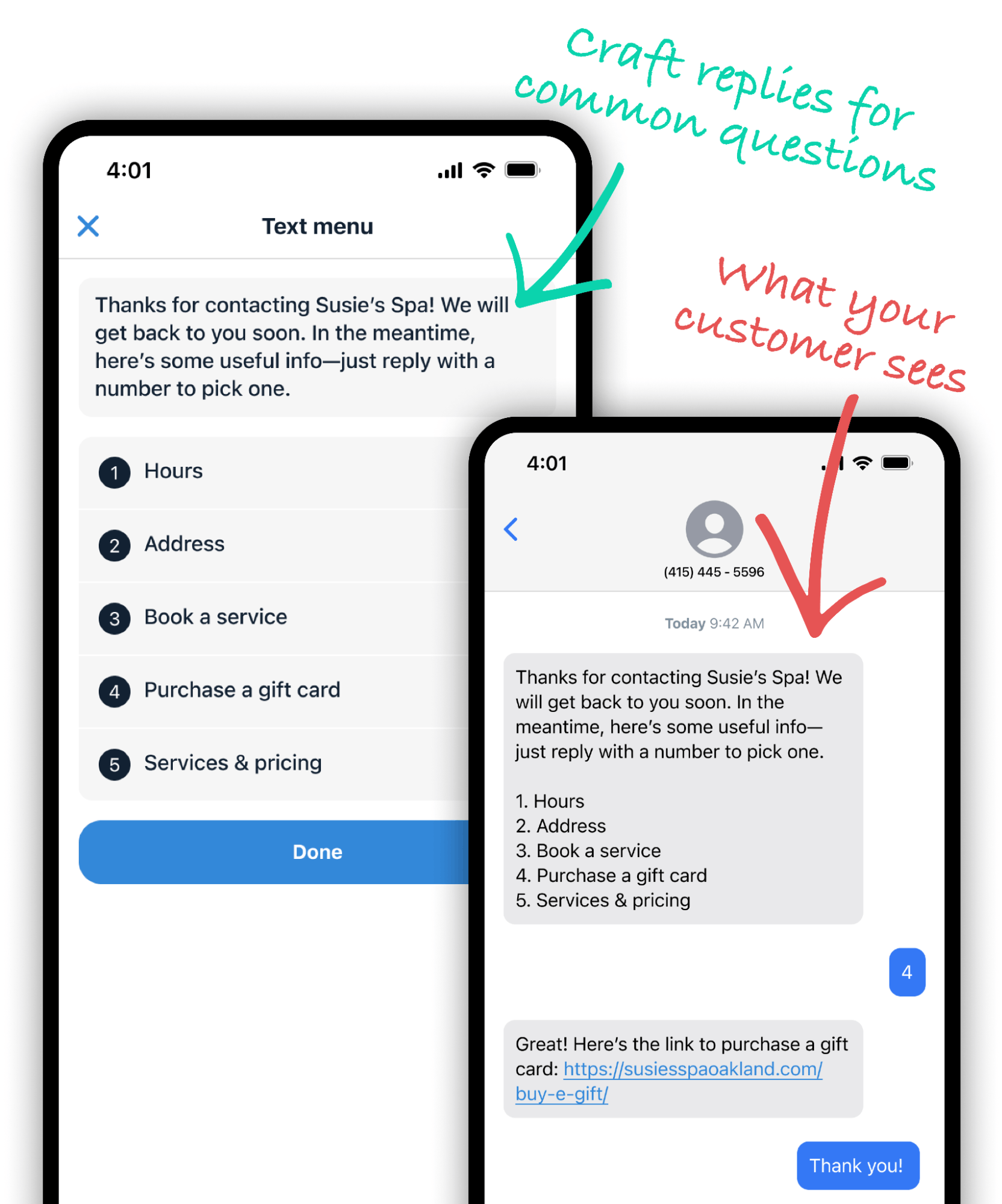5 marketing tips every small business providing a service should try in 2023

Whether you’re a fortune 500 company, or a solo journeyman, providing the services you’re selling and running your business, you must invest in some level of marketing to make sure your business remains profitable, and continues to grow.
Though the budgets, people, and tools might differ between a large corporation, and a small or medium-sized business, the same principles apply (just at a different scale). Today, we’re going to outline our top 5 principles and provide some tool suggestions to help even the smallest of businesses boost their revenue in 2023.
The basics
Most marketers refer to the below diagram as a customer journey, or a sales or marketing funnel. For those newer to marketing, the goal of this visualization is to help map out the various stages a person goes through as they look for, engage with, and ultimately become a customer of any given business.

To over simplify:
Awareness is all about making sure that when it comes time for a customer to have a need that matches what your business can offer, you are discoverable as a solution.
Interest, consideration, and evaluation are about making sure when that customer is aware of your business, that they can easily get the information they need in order to make a decision about a purchase.
Decision and purchase are all about being as friction free as possible for that customer to buy, whether that’s purchasing a good, service, or experience.
And repeat, loyalty, and advocacy are all about turning that one time customers into an agent of growth, helping you fill the top of your funnel with customers who need less convincing.
As mentioned earlier, the funnel is not meant to give you solutions, rather it’s a great starting point for you to consider what tactics, technology, and time you want to put into different areas of the funnel to help your business grow. A promised, in this article we’ll give you 5-marketing tips that are proven to help businesses of all size and category grow.
1. Invest in social. Though often hard to measure the impact of social media, it is no longer a question of if you do it, but how you do it. With people spending roughly 2 hours and 23 minutes daily on social media (GlobalWebIndex), and over 4.55 billion active users globally (Social Media Today), you can no longer afford to sit on the sidelines.
For small businesses in 2023, Instagram (owned by Facebook) and Tiktok are two platform you can’t afford not to be on. While Facebook (which most small businesses are on) still has billions of people visiting on a daily basis, in the US, younger generations have moved a massive amount of that time away from Facebook towards Instagram and Tiktok. Tools make it pretty simple to publish cross platform, so adding those two into your mix should not cause too much extra effort.
There is an overwhelming amount of content out there about how to approach social media, so before you begin, educate yourself a bit, then make a plan. Here is short list of our favorite resources:
- HubSpot - with a great marketing blog that covers a wide range of things, you can find specific social media content, and even platform specific learning tools like this one. For those who really want to dig in, their free marketing academy is actually quite good as well.
- Social Media Today - while not every article will apply given the resources of a small or medium sized business, you will be able to get a ton of helpful nuggets from many of the articles. Like this one, that suggests the best time of day to post, or this one that has some helpful tips for planning.
- Instagram for business - if you’re not already following them, Instagram has their own handle and they post tips and tricks to help make you successful. Here’s a particularly good post with 8-tips for engaging your audience.
Once you have your plan, it’s really about posting good content regularly and growing your audience by following and engaging with them. For content creation, there are also a ton of tools out there. These two are my favorite right now, because they’re both easy to use and inexpensive:
- Mojo - one of the best tools for creating beautiful content directly on your mobile device, without a design, it’s easy to use, makes everything look professional, and is completely free! They have paid upgrades, but you can go a long way on the free product
- Canva - if you haven’t heard of Canva by now, this should be your first stop. Not only can you easily create cute, animated content for different social platforms, but it’s a great tool for all your flyers, leave behinds, and more traditional marketing collateral. And this product also has a free offering with a lot of functionality.
Of all the tips in this article, this is likely the most time consuming so I’d suggest starting with the other four lower hanging fruit, then circling back.
2. Respond quickly to customers. Though this one may seem obvious, you’d be shocked by how many people miss out on business due to poor response rate. In fact, according to Forbes the average lead response time is close to 47 hours and only 27% of leads who reach out, particularly online, ever get a response at all!
According to small business trends, 82% of consumers expect immediate responses on sales and marketing questions, and if they don’t hear back, move onto the next business.
As a small or medium sized business, you may be thinking you’re up against impossible odds, especially if you are still in the phase of growth where you need to actually provide the service you’re selling, making it impossible to get to the phone. Good news is that there are a few path here you can take: tools, hire, outsource.
Tools: In 2023, there are now tools that help automate responses so that customers hear back from you right away, even if you’re too busy to get to the phone.
At Tellhop, not only do we offer simple, triggered text based automations, but our phone system also provides interactive menus you can turn on that potential customers can engage with via text, the preferred means of communication for 9 out of 10 consumer today (Global News Wire). So when you miss a call, you’re not missing out on business.
Here’s how it works: You can configure it to trigger if you miss a call, or receive a text from a customers. Once that “event” happens, the customer instantly gets access to a menu of text options that get them to the information they need!

You can customize the menu so it can have the options that make sense for your business. In the case of qualifying a lead, or booking an appointment, that customer can text all the information needed and that investment alone on the customer side makes them 10x more likely to wait to hear back, then do the same “work” with another business.
Other options here are to hire more employees, or choose a platform where you can outsource a call center, likely cheaper than hiring, but can come with all sorts of other issues that Business’s article on outsourcing does a good job of outlining.
Today, the cheapest of all three options is for sure tellhop, with plans starting at $5 a month, but we encourage you to explore all three paths before making a decision.
3. Text based appointment reminders. No shows (or not home if you go to the customer) are a big hit for businesses, both from a time and money perspective, with stats showing that 62% of no shows occur simple because the customer forgot (Voiceage). And while calls and emails used to be a great way to connect with customers, given stats around how often different segment of people check voicemails and emails, sending those messages via text would increase your communication efficiency by 6000% (OffTheCusp).
Depending on if you’re using pen and paper, a basic calendar (like Google or Outlook calendar), or are already set up with a booking system (which should have text reminders), text based reminders are not hard or too expensive to add to your current workflow.
If you’re on pen and paper, and you don’t want to switch to an online calendar, our suggestion would be scheduled text messages that you set up when you’re adding the appointments to your calendar.
Here are a few cheap or free tools you can use to do that:
- Tellhop - the ability to write and schedule any type of text message at some point in the future (date & time) is a feature that you can access in tellhop on any plan.
- Zapier - this is a really neat tool that lets you connect different types of software (or set rules for a software program you’re use, like your phone’s messaging!) and create automation that save you time. Here is their template for scheduling a text.
- Free options from a cell phone:
undefinedundefined - TextMagic - this is a very easy-to-use service that is pay as you go, super great for when you’re just staring out, but it can get costly quickly so just keep an eye out!
For those who use Google or Outlook calendar, I cannot recommend Calendly enough. It’s super easy to use, the plan with text based reminders is only $12 a month (as I’m writing this article) and you can automate both scheduling appointments, and the reminders. Here is a quick article on how to set those up, but this won’t work for everyone so please check out the product before you buy (like all of our suggestions).
There are also many options out there segmented to fit your particular type of business, but those tend to be a little more pricey.
4. Post service follow up. In this day and age, when so many people base their buying choice on publicly available customer reviews, it’s important to try and corral customer feedback as, on average, a happy customer tells 9 people, and an unhappy customer tells 16 (Zippia). On top of that, 96% of unhappy customers never actually complain to the company about their bad experience (LXAhub).
So what does that mean for your small business? The simplest tip is to send a follow up text, email, or call to see how satisfied your customer was with the job done. If you have a happy customer, great! You simply reply with gratitude for spending with your business. If they’re really happy, you can ask them to review you wherever it matters most for your business. For some, that will be Yelp. For others, it might be your Google page, or your own website.
For customers who are not satisfied, the most important thing is to hear them out and, where possible, correct any wrong doings they feel they suffered. Check out our blog post on customer service cheat sheet for more tips.
5. Texting to get customers coming back. Many businesses are allergic to the thought of bombarding customers with unwanted text messages or even emails, but there’s a 60-70% chance an existing customer will make a second purchase as opposed to a 5 - 20% change a first-time shopper will, so those follow ups are important(Zippia).
And why text you might ask? Not only do customers prefer it (as we learned earlier), but the average open rate is 98% (as opposed to email’s 20%), response rate is 45% (email is 6%) (Gartner), and on average it takes 90 seconds (Business2community) to get a response.
So the biggest questions are: when and what
The most important aspect of the follow up is to make sure you understand your customer needs and match the follow up with those needs. Getting a text from a business asking if you need a haircut a week after your last haircut makes no sense, and is likely to annoy your customers. But match the timing to a customer need with the link to book your service, is absolutely delightful as they don’t have to go digging to find your contact info.
Using the last example, standard data says that on average, men get hair cuts every 4 - 6 weeks and women, ever 3 - 4 months. When your last appointment walks out, or at the end of the day, schedule texts to go out in the future for everyone you see that day so when that time comes around, you’re not only helping them remember you exist, but you’re making scheduling that appointment easy.
If you already have a POS (point of sale software) or a CRM (customer relationship management software), you can likely look up exactly what each customer’s ideal timing looks like, though averages are likely fine.
There are marketing tools that automate a lot of this for you, though they can be quite expensive, particularly as you ramp up on customers or message volume. A good goal for 2023 might be to start the process in a more manual way so you can start to see the impact: is it driving more business? How do customers find it? Do they like it? What else would be helpful for them?. In software development, we often try to put out small changes, then talk to customers to hear how they feel. Your service business is no different, your customers are your best partners! Talk to them, many will love to share their thoughts.